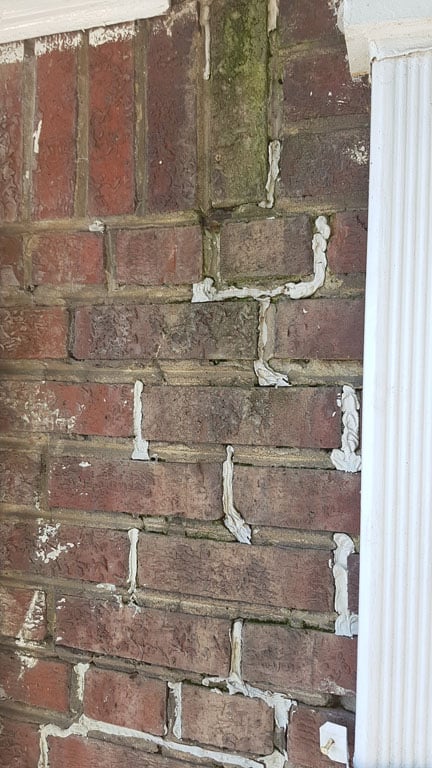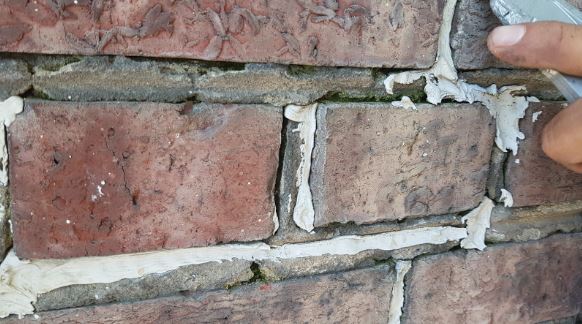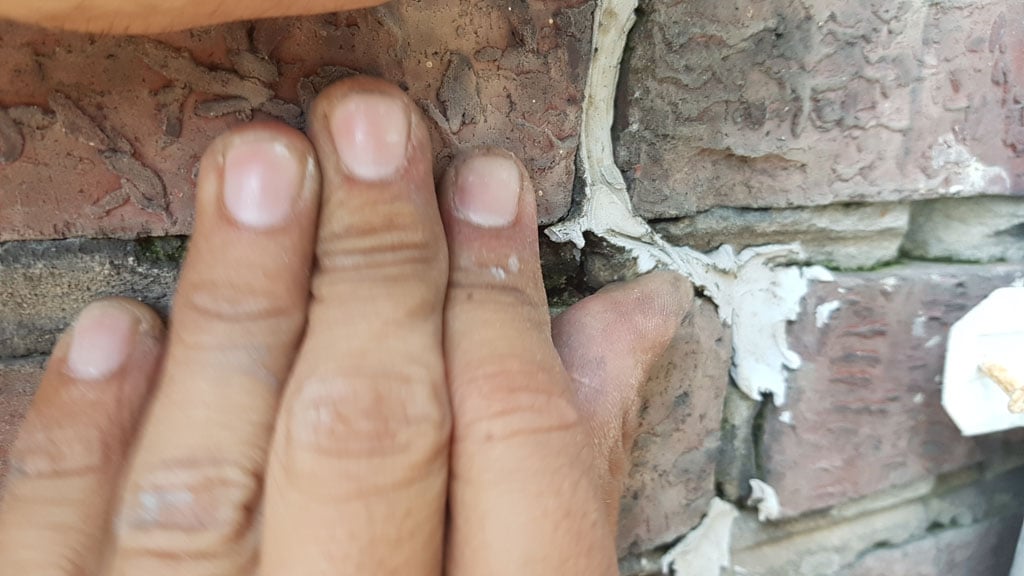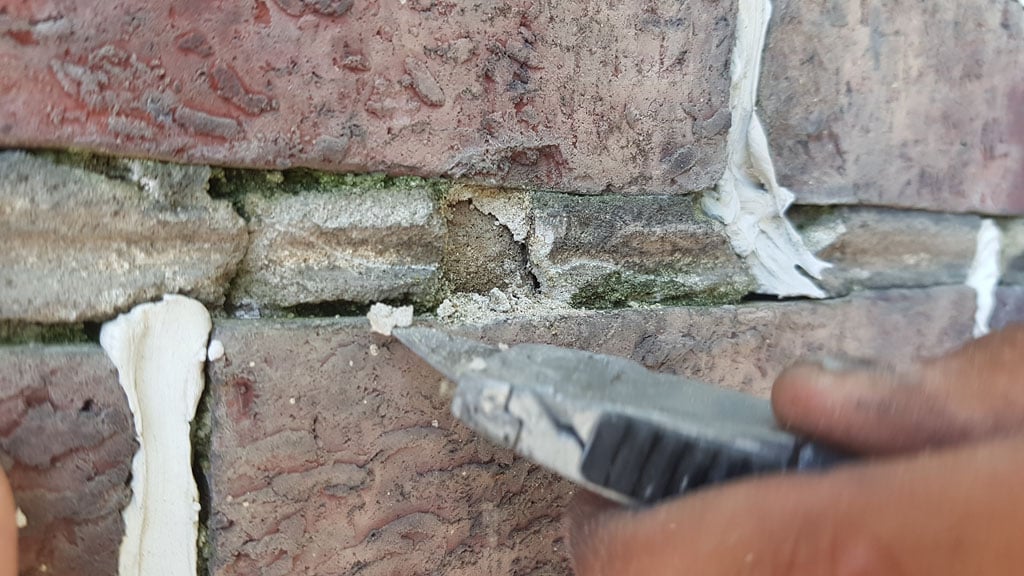Learn about caulking mortar joints from experts
In almost all cases, it’s very bad to caulk brick mortar joints. People often apply caulk as an alternative to proper masonry restoration and tuck pointing, its wrong and should bever be done. Tuck pointing or repointing is an important and necessary procedure required to maintain historic masonry buildings. The historic restoration or tuckpointing process does not have to happen often. In fact it can happen only so often, once every few generations, so relatively low cost considering the longevity. The work is extensive, but in most cases will be sufficient to keep the building in overall decent condition, at the exterior of the masonry or brick wall facade, for decades. The rest of the routine seasonal maintenance can be relatively limited, small and scale, and relatively low cost. The remaining seasonal upkeep can be limited to repair and maintenance outside of extensive repointing.
(As a side note, we will post a follow up article, as the third in this 2-part series on this same topic but at a different angle and side of the issue. There are particular circumstances where elastomeric sealants should be applied in special details and at special elements at the masonry facade. Those areas and methodologies are different and distinct to caulking mortar joints as an alternative to proper restoration. )
Why Caulking Mortar Joints Hurts A Building
 The picture here shows an example of caulk applied to brick mortar joints as a shoddy attempt to stop water ingress through the exterior masonry facade.
The picture here shows an example of caulk applied to brick mortar joints as a shoddy attempt to stop water ingress through the exterior masonry facade.
Proper historic brick tuckpointing or repointing benefits a historic building for several reasons. The list below includes several reasons why applying caulk as a makeshift alternative hurts the building more than it helps.
Why caulking mortar joints is bad:
- Structural void
- Aesthetics
- Irreversibility
- Partial delamination
- Permeability mismatch
Structural Void
Proper brick restoration and brick repointing or tuckpointing is required on old and / or historic buildings, for several reasons. One of those main reasons is to stabilize the brick joints at the outward face of the exterior wall. Another side benefit of repointing or tuckpointing is that the wall also has better, closer to original structural capacity, after pointing.
The mortar between bricks and the bricks themselves are structural elements. They are heavy in themselves but can support the incredible heavy load of buildings. Buildings are simply very weighty, they are amalgamations of a significant amount of mass, scale and size.
Aesthetics
It’s easy to understand that a properly tuckpointed or repointed brick masonry facade has a clean and crisp look and aesthetic. The visual difference between a newly repointed building and deterioration, unrestored brick facade lis striking. A restored brick building can look fresh and new in many ways.
In contrast, caulking the joints looks sloppy and overall jjyst ugly. This unprincipled practice leaves the old deteriorated mortar in place and then puts a white, goopy line squiggled throughout the old mortar. By comparison, while the existing original or older mortar is a light gray color, the caulk is generally a bright white color which stands out in contrast.
Irreversibility
Different caulkings are made of different substrate materials. Some caulking materials are latex based and intentionally made to be water soluble for easy clean up, other caulks are instead weather resistant so have low permeability properties. Some caulkings also have siliconized or acrylic components which makes clean up Or removal very difficult.
In the case of the caulk applied in the picture below, this material has been applied to the exposed face and edges of the brick which will remain exposed even after a proper tuckpointing has been completed. This is very problematic and complicated because the brick will be essentially stained with this poorly, incorrectly applied and inappropriate material. The damage is long lasting if not permanent.
Partial Delamination
Even though in the section above, we discuss problems with the permanent type of attachment of caulking materials, another inherent problem in the use of this material is that it will also partially delaminate from deteriorated mortar joints and brick facade surfaces. It sounds like a little bit of a contradiction but it’s actually predictable and it in some ways is largely based on the condition of the substrate. Where the caulking is applied directly to the brick facings, the caulk will generally stick very well because the brick is more solid than the old deteriorated mortar. Kiln fired clay brick units themselves will deteriorate over time: however, where the caulking is attached to the mortar only, at some spots where that motor is already significantly deteriorated, the caulking will delaminate at the mortar joint but not at the brick.
The problem inherent in spots of caulking delamination is that there will not be consistent delamination and therefore as particular spots delaminate at one area but not all areas, water can be trapped behind the partially deliminated material. A water sits behind the partially delaminated materials, that water will dry away at a much longer time period and stay in contact with the substrate deteriorated mortar for longer than it would otherwise which leads to increased ingress of water. This then leads to increased hydration of materials which leads to more extensive damage to the substrate mortar joints.
Permeability Mismatch
One of the biggest problems with the installation of improper mortar is that modern mortar will have lower permeability than historic mortar. Permeability isn’t necessarily a good thing, but it’s extremely bad when a less permeable mortar is installed at the outer edge of a historic brick or historic masonry wall. The same principles apply when caulking is applied at the outer edge of a historic brick joint. That caulking will trap water behind it in the motor joint, Similar to areas of caulking delamination, this is problematic, but it’s even worse when the mortar does not delaminate and instead traps moisture between the mortar and the attached caulking. in freeze-thaw cycles, that precipitation or moisture will freeze and expand and cause damage to the bricks themselves. This type of damage can be extremely expensive to repair because replacing bricks is even more expensive than repairing or replacing the brick mortar.
In the picture below, you can see that there are loose pieces of mortar, so loose that they can be moved by hand alone.
The caulk has been applied as some sort of cheap and dirty, makeshift type repair but it’s not really doing anything positive. In fact the pieces of mortar which should have been removed behind The current location of the caulk are still in place and loose to the touch.
Considering the type of damage caused as a result of this type of treatment, it starts to sound less like building improvement and more like vandalism. The DC code, not the Building Code, regarding vandalism is really interesting because as written it requires malice, and malice as defined requires ill intent. So while the destructive nature of this type of “work” feels akin to vandalism, it technically might not fit in that category, per the DC code.
To really understand why something like this would be done to a building, you have to understand more about the market of building caretakers, stewards, building owners, and contractors in the Washington DC area. Many property flippers, some contractors, and some owners are just trying to make quick money and sell a property fast for more than they paid and some rental owners hire the cheapest contractors they can find. Cheap and unskilled go hand in hand.
What Is A Scam Point
In the image below, you can see that as we were there at the building to check the condition of the mortar, we also probed at the existing mortar behind and around the caulking and found that the work previous to the caulking had also not been applied properly. The owner or previous workers had applied a scam point. A scam point is an application of a thin layer of mortar without raking the existing joint to remove the old deteriorated mortar. You can see that just below the surface of the existing mortar, there’s a layer of unraked original mortar.
This building happens to be a historic building, slightly newer than and outside of the area of buildings in the historic district of Washington DC. Nonetheless, the mortar used to point this wall should have been a lime rich low PSI brick mortar and that mortar should have been installed in a fully raked joint to the 3/4 to 1.25″ depth.
To properly maintain, repair, and care for these historic buildings, a knowledge, interest and understanding of historic building principles is required. Here in Washington DC, historic masonry buildings are extremely expensive and the amount of financial loss caused by improper repointing and low quality construction is staggering. However, in addition to the direct financial value of the property, there is also a cultural loss when historic buildings are damaged. By comparison, consider neighboring poor cities, when historic buildings are damaged, it’s not just the loss of value to the property owner, there’s also a loss to all inhabitants and visitors of a city, present and future, who care about architecture, history, and culture.
How To Avoid Building Damage
We encourage all of our clients, and all readers of this article and to our blog in general, to prioritize the historic built environment of Washington DC and neighborhoods such as Capitol Hill, Dupont Circle, and Georgetown and become educated on on the difference between proper historic preservation versus improper work which leads to significant damage to the historic fabric of a building.
From a conservation and preservation perspective, several approaches can be taken to improve conditions related to deteriorated historic brick masonry. Primarily, lime mortar brick joints and low temperature fired soft red clay bricks should be inspected and checked on a routine maintenance schedule, either seasonally or at least annually. If brick masonry is kept in good condition, the life of embedded wood elements can be significantly extended. Hire a professional contractor which specializes, understands and appreciates historic construction elements and buildings.
In this article we talked about the terminology and concepts of historic masonry restoration, follow the links below for more related information from the IDS website:
- Binders in mortars and concrete
- Brick burns
- Butter joint
- Capillary action
- Cantilever
- Cementitious siding
- Cheek wall, masonry — Draft
- Chemical testing
- Code, building — Draft
- Cold joint
- Cold weather masonry work — Draft
- Damp proof course
- Downspout
- Electrical distribution panel — Draft
- Fenestration
- Ferrous metals
- Great Chicago Fire
- Green bricks
- Gutter, roof
- Lime mortar
- Lintel
- Load path
- Oriel window
- Oxidation
- Parapet coping
- Plug, clay
- Pressed bricks
- Raking, of mortar joints
- Raggle, aka reglet
- Rectilinear
- Roman bricks
- Roman arches
- Roof eave
- Roof termination
- Row buildings and row homes
- Rubbed bricks
- Sedimentary rock
- Scratch coat
- Sprung arch
-
- Squint bricks,
- Strike, or striking of mortar
- Tapestry bricks
- Tooth-in, interlocking masonry connections
- Vitreous
- Water diversion systems
- Zipper-joint
These concepts are part of the fundamentals of historic masonry restoration, tuckpointing, and brick repair.
The links in the list above will take you to other articles with more information on defects, failures, preservation and repair of historic masonry. You can learn a lot more on our blog. Feel free to check it out. If you have questions about the historic masonry of your building in Washington DC, fill out the webform below and drop us a line. We will be in touch if we can help.




